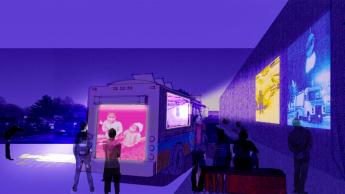Broadening the Arts Umbrella
September 08, 2021

New initiative expands offerings; unites arts, STEM and social justice.
By Sala Levin ’10 | Maryland Today
A new initiative at the University of Maryland will expand arts programming across campus and bolster interdisciplinary offerings, creating new opportunities for students and faculty to fuse the arts, technology, innovation and social justice.
Arts for All, announced by President Darryll J. Pines in his inauguration address last week, will include an Academy for Immersive Arts and Performance, new courses that sync computer science with the arts, new majors and certificates, added faculty and staff positions, pop-up musical performances in spaces across campus, a scaled-up annual NextNOW Fest produced by The Clarice, and more.
“The goal is that every student at Maryland would have a meaningful arts engagement while they’re here,” said Bonnie Thornton Dill, dean of the College of Arts and Humanities (ARHU). The initiative aims to improve student experience by “addressing what we see as growing demand and interest of integrating the arts into life both within and beyond the curriculum, and providing opportunities to combine arts interests with other fields,” she said.
The new immersive media design major exemplifies how the initiative links together the arts and STEM fields. A joint offering from the Department of Art and the Department of Computer Science, the major, which launches in the fall, teaches students to use technologies like virtual and augmented reality, computer graphics, coding for new ways of displaying art virtually, 3D modeling and more.
“We are the first in the nation to launch such a major that is perfectly balanced and harmonious between computer science and art,” said Amitabh Varshney, dean of the College of Computer, Mathematical, and Natural Sciences. “From the very beginning, one of the things I loved about this major was that it was striking that balance.”
The eventual Academy for Immersive Arts and Performance will provide a place where students, researchers and members of the community “can come together and create new things in really innovative ways,” said Thornton Dill.
In addition, the Maya Brin Institute for New Performance, established through a gift from mathematics Professor Emeritus Michael and Eugenia Brin, along with the Brin Family Foundation, will add courses, expand research and fund new teaching positions, undergraduate scholarships, classroom and studio renovations, and instructional technology. The Brin family, including Google co-founder Sergey ’93 and Samuel ’09, have long been supporters of UMD and of STEM in the arts.
The initiative includes the David C. and Thelma G. Driskell Award for Creative Excellence, to be given annually to a graduate student or recent alum whose research is inspired by David C. Driskell or the David C. Driskell Center collections, and embodies the late artist and professor’s values of leadership, collaboration, mentorship and racial justice.
Reaching beyond campus, ARHU and the School of Architecture, Planning and Preservation (MAPP) are developing a new certificate in creative placemaking, led by architecture Professor Ronit Eisenbach. “Creative placemaking is an evolving field of socially engaged artistic and design practice that intentionally leverages the power of arts, culture and creativity to serve community interests,” said Eisenbach.
Students will participate in the Purple Line Corridor Coalition’s Thriving Communities Initiative, which seeks to build on opportunities and address the challenges of incorporating a light rail line into the community, and with the Partnership for Action Learning in Sustainability (PALS), which works with local governments and community groups to tackle social, economic and environmental sustainability projects.
Terps will collaborate with “local artists, culture bearers and knowledge keepers” to invigorate unused spaces and build relationships—whether by driving vans-turned-internet cafes through a neighborhood, building a pop-up playground, planting a garden or painting a public mural, said Eisenbach.
“We in (MAPP) are thrilled to partner with ARHU on this new initiative,” she said. “Artists and designers can play a valuable role in exploring our shared humanity and addressing some of our major challenges, whether … climate change or celebrating the diverse communities and cultures around us.”
See how students and faculty in UMD's School of Theatre, Dance, and Performance Studies collaborated on a dance film inspired by Virginia Woolf's novel "Orlando" that pivoted the production from stage to film.
This story appears in Maryland Today.
Top photo: The new Arts for All initiative will expand arts offerings across campus, uniting them with tech (as in the projected artwork at The Clarice Smith Performing Arts Center). "art is water, seeds are change." created by interdisciplinary artist and multimedia designer Alexandra Kelly Colburn M.F. A. design ’18. Photo by David Andrews.
Second photo: The initiative will also serve the community (as in the rendering of a mobile arts van, from architecture Professor Ronit Eisenbach's Making Place studio).
(Originally posted April 28, 2021)


